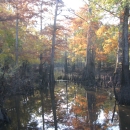Visit Us
Overflow National Wildlife Refuge offers an instant wildlife viewing adventure. Birds, mammals, reptiles, and amphibians of all shapes and sizes can be viewed on the refuge.
Trails
Waterfowl Sanctuary Road
Open September 1 to October 31, then from April 2 to June 30 for wildlife viewing and photography.
Length: .75 miles
When open, vehicles must remain on the established road as indicated on the map of the Public Use Brochure. Vehicles may be parked alongside the open road in a manner that will not interfere with the normal flow of traffic, or park no more than 20ft off the graveled road. For questions or concerns, contact the refuge office.
(Please note: the road closures are from November 1 to April 1, and then from July 1 to Aug 31.)
Other Facilities in the Complex
A National Wildlife Refuge Complex is an administrative grouping of two or more refuges, wildlife management areas, or other refuge conservation areas that are primarily managed from a central office location. Refuges are grouped into a complex structure structure
Something temporarily or permanently constructed, built, or placed; and constructed of natural or manufactured parts including, but not limited to, a building, shed, cabin, porch, bridge, walkway, stair steps, sign, landing, platform, dock, rack, fence, telecommunication device, antennae, fish cleaning table, satellite dish/mount, or well head.
Learn more about structure because they occur in a similar ecological region, such as a watershed or specific habitat type, and have a related purpose and management needs. Typically, a project leader or complex manager oversees the general management of all refuges within the complex and refuge managers are responsible for operations at specific refuges. Supporting staff, composed of administrative, law enforcement, refuge manager, biological, fire, visitor services, and maintenance professionals, are centrally located and support all refuges within the complex.
Rules and Policies
Public Use Regulations are designed to protect the sportsman and wildlife populations. The Public Use Regulations provided supplement the general regulations which govern all public uses on National Wildlife Refuges as set forth in Title 50, Code of Federal Regulations. Hunting and fishing will be in accordance with applicable State regulations subject to the conditions listed in the brochure.
Refuge Access Permits are required for all refuge users. When signed and in your possession, the cover section of the Public Use Brochure serves as your permit for all refuge hunts and other permissible activities, and acknowledges your understanding of the regulations contained within the brochure.
A Refuge Special Use Permit is required for all commercial activities on the Refuge. Furbearer trapping is allowed on Overflow NWR by Special Use Permit only. Permits may be obtained by contacting our refuge Headquarters with a formal request. All Special Use Permit applications will be subject to a two week turn-around time.
Locations













Overflow National Wildlife Refuge is located 15 miles southeast of Hamburg, Arkansas, adjacent to State Highway 8, or four miles northwest of Parkdale, Arkansas on State Highway 8. Signs along the way invite you to visit the Office/Contact Station before entering the refuge.

